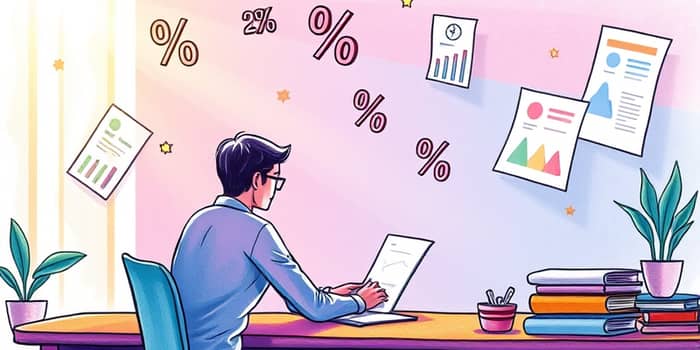
Understanding personal loan interest rates can transform the borrowing experience from stressful to empowering. In mid-2025, market dynamics, borrower characteristics, and lender strategies converge to determine the cost of a loan. This article dives deep into the forces shaping personal loan APRs, offering comprehensive view of your financial health and actionable insights to secure the most favorable terms.
As of mid-2025, personal loan interest rates reflect economic shifts and competitive pressures among lenders. The national landscape shows:
These figures reflect both secured and unsecured offerings, with top-tier applicants accessing single-digit rates while riskier profiles face steeper charges.
Your credit score is the most influential factor in determining your personal loan rate. Lenders segment borrowers into tiers, each carrying distinct risk assessments. The table below summarizes average APRs from major sources:
Subprime applicants (scores under 620) often encounter APRs exceeding 100%, or may be declined outright. This stark divide highlights the the pivotal role of credit history in loan pricing.
Beyond credit scores, lenders evaluate multiple variables to set your APR. Understanding each component helps you optimize your profile before applying.
Each factor plays into a holistic risk-based pricing model, prompting lenders to balance potential defaults against prevailing market conditions.
Lenders use sophisticated algorithms combining borrower data with economic indicators. Core elements include:
Risk-based pricing frameworks assess credit history, outstanding obligations, income stability, and employment. Meanwhile, macroeconomic influences—such as Federal Reserve policy rates and inflation expectations—anchor the baseline cost of funds.
The quoted APR encompasses both interest and applicable fees, offering a transparent measure for side-by-side comparisons. By focusing on APR rather than nominal rates, borrowers gain the most accurate borrowing cost picture across different loan products.
Personal loans often undercut credit card rates and provide fixed payments. Key contrasts include:
For consumers seeking stable repayment schedules, personal loans can balance risk and reward effectively, especially when consolidating high-interest debts.
Borrowers tap personal loans for diverse life events and financial needs. Leading uses include:
In Q1 2025, the average personal loan debt per borrower stood at $11,631. Delinquency rates improved slightly, with just 3.49% of accounts 60+ days past due. Lenders like Happy Money and Reach Financial specialize in debt consolidation, targeting customers eager to replace revolving debt with fixed-rate, single-payment loans.
Armed with knowledge, you can take strategic steps to lower your APR:
By implementing these tactics, you can empower borrowers to make informed decisions and achieve financial goals with confidence.
Online calculators allow you to model monthly payments, total interest, and amortization schedules for various amounts, terms, and rates. These tools provide clarity, helping you unlock lower interest rates and savings by selecting the ideal loan structure.
In 2025, interest rates remain higher than pre-pandemic lows. While top-tier borrowers enjoy highly competitive offers as low as 5.99–6.49%, subprime applicants may encounter prohibitive costs. Always check prequalified offers to uncover your genuine rate, rather than relying on advertised headline figures.
Understanding the forces behind personal loan APRs equips you with the confidence to navigate the market. By improving your credit profile, exploring multiple lenders, and utilizing digital tools, you can secure terms that align with your budget and goals. With this navigate the complexities of loan pricing guide, you’re ready to approach borrowing with insight and empowerment.
References













